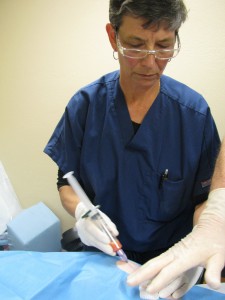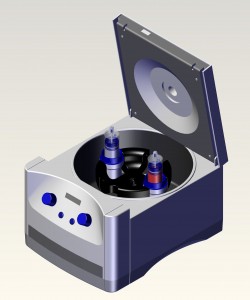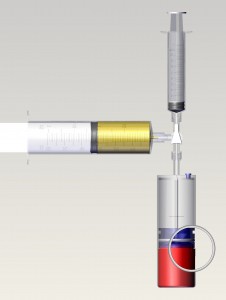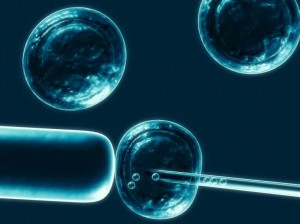Adult Stem Cells And Platelet Rich Plasma Therapy in Regenerative Medicine
Dr. Annette Zaharoff, M.D.
Regenerative medicine is an evolving new field of medicine which enhances the ability of a patient’s own body to heal an injury and reduce pain. Science has demonstrated the important role blood platelets play in our body’s ability to heal. In the 1990’s, regenerative medicine took advantage of the important role platelets play in our repair process by concentrating blood platelets into Platelet Rich Plasma (PRP) concentrates for wound and injury site healing. Platelets contain important growth factors and control the natural healing cycle of the human body, namely the inflammatory cycle. New cells and growth factors are recruited by the platelets and promote healing of an injury.
Advances in regenerative medicine are now incorporating adult stem cells (known as progenitor cells, from the Latin word for “parent”) to boost the repair cycle even more. These progenitor (stem) cells have the ability to differentiate into a variety of connective tissues; namely ligaments, tendons, muscles, cartilage, and bone. Increasing the number of stem cells at an injury site increases the body’s ability to heal. Our bodies use adult progenitor (stem) cells for internal repairs and maintenance all the time. Without them, we would not be able to heal a wound, repair a fractured bone, or maintain our basic organ systems and functions. PRP/stem cell therapy combines high concentrations of PRP with adult stem cells which are then injected into injury sites to provide an even more powerful healing response.
Where do the Adult Stem Cells Come From?
Adult stem cells have the capability to evolve into connective tissues (ligaments,
tendons, muscle, and cartilage) and are stored primarily in bone marrow and adipose (fat)
Note that adult stem cells are taken from an individual and returned to that individual (known as autologous tissue) and have nothing to do with the use of embryonic stem cells or the use of another person’s tissues.
What Type of Injuries Can be treated?
 Since stem cells have the ability to differentiate into connective tissue a wide variety of musculoskeletal problems can be treated with adult stem cells. PRP/stem cell therapy may be used for most degenerative joint conditions as well as muscle, tendon, and ligament injuries. Some of the injuries treated include:
Since stem cells have the ability to differentiate into connective tissue a wide variety of musculoskeletal problems can be treated with adult stem cells. PRP/stem cell therapy may be used for most degenerative joint conditions as well as muscle, tendon, and ligament injuries. Some of the injuries treated include:
• Shoulder pain from rotator cuff tendon injuries
• Tennis elbow and carpal tunnel syndrome
• Ligament damage in the knee and ankle
• Plantar fasciitis and Achilles pain
• Arthritic hip and knee joints
• Neck and low back pain from herniated discs or degeneration
Many athletes use PRP/stem cell therapy to treat acute injuries to speed up the healing process and get back in the game ASAP. When our body is not healing effectively we develop chronic, recurring and nagging injuries. Using PRP/ stem cell therapy can boost growth factors and new cell growth at the chronic injury site and kick start our body’s natural ability to heal.
How is this procedure performed
A compre hensive evaluation is performed by Dr. Zaharoff in order to identify the problem and determine a specific diagnosis. A treatment plan is developed for each individual case by case and may include PRP/stem cell therapy.
hensive evaluation is performed by Dr. Zaharoff in order to identify the problem and determine a specific diagnosis. A treatment plan is developed for each individual case by case and may include PRP/stem cell therapy.
PRP/Stem cell therapy combines two of your body’s most important ingredients needed to repair an injury. First, platelet concentrates are obtained from a small volume of whole blood drawn from the patient which is placed in a FDA approved centrifuge device to isolate and concentrate the platelets. Under local anesthesia, a small volume of fatty tissue is removed with a cannula and syringe. A low suction device is used in order to preserve the needed fat tissue and associated stem cells found attached to the fat cells and adjacent small capillary network. Once completed, the progenitor (stem) cells are combined with the PRP and precisely injected into the targeted location of damaged or injured tissue using high definition, ultrasound guidance.
Treatments are performed under local anesthesia. Depending on the injury, more than one injection may be needed during the procedure. Most patients tolerate this; however some patients may require medication for pain control prior to the procedure.
What happens after the procedure?
After the procedure, anti-inflammatory medications are avoided (Motrin, ibuprofen, Aleve, Mobic, etc.) as these may slow or limit your ability to fully heal the problem area. If you are taking a single, low dose aspirin for other medical reasons, this low level anti-inflammatory will not interfere with recovery.
Oral pain medications such as Tylenol or a prescribed pain medication may be used for discomfort if needed. Range of motion exercises to the area is encouraged the week after the procedure while more aggressive exercises are generally avoided for two weeks or until you have been rechecked by Dr. Zaharoff. We encourage patients to carefully “listen” to their body and avoid potentially harmful activities in the early post-treatment period.
In some cases, more than one treatment is needed, usually two to three months after the first treatment. This is often true in the more extensive or complex cases. Additional PRP booster treatments may be recommended at 6 weeks to ensure that all the adult stem cells become activated. Dr. Zaharoff will discuss this with you in your follow up appointment.
What can you expect?
Everyone is different in their healing process and results can also vary with severity and chronicity of an injury. The body’s natural healing cycle generally takes 2-3 months to generate new healthy tissue and anywhere from 3-12 months to maximize the strength of that new tissue. We hope to see some positive effects within 3-4 month after the procedure with reduction in pain
As with any injury, it is important that a thorough evaluation be performed and a comprehensive treatment plan be outlined for each patient as an individual. Injections may be recommended as part of that treatment plan but are never a substitute for appropriate rehabilitation.
Our staff is ready to assist you in scheduling an office visit or consultation, call (210) 616.0646. If you have questions for Dr. Z, please forward via our contact form.

